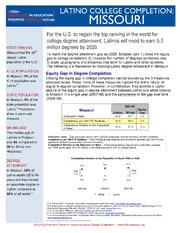
ERIC ED532118: Latino College Completion: Missouri PDF
Preview ERIC ED532118: Latino College Completion: Missouri
LATINO COLLEGE COMPLETION: MISSOURI For the U.S. to regain the top ranking in the world for college degree attainment, Latinos will need to earn 5.5 million degrees by 2020. STATE RANKING Missouri had the 30th To reach the degree attainment goal by 2020, Missouri can: 1) close the equity largest Latino gap in college completion; 2) increase the number of degrees conferred; and, population in the U.S.1 3) scale up programs and initiatives that work for Latino and other students. The following is a framework for tracking Latino degree attainment in Missouri. K-12 POPULATION Equity Gap in Degree Completion In Missouri, 4% of the Closing the equity gap in college completion can be tracked by the 3 measures K-12 population was provided below. Alone, none of these measures capture the entire “story” of Latino.2 e quity in degree completion. However, in combination, they provide a useful picture of the equity gap in degree attainment between Latino and white cohorts STATE POPULATION in Missouri in a single year (2007-08) and the persistence of the gap over time (2006-08). In Missouri, 4% of the state population was 2007-08 Latino.3 Projections Missouri Equity Latinos Whites Gap show a continued Graduation Rates 45.8 49.7 3.9 increase. Completions per 100 FTE Students 16.3 18.4 2.1 Completions Relative to the Population MEDIAN AGE in Need 24.0 37.5 13.5 The median age of Latinos in Missouri Graduation rates - Total graduation within 150% percent of program time for first-time, full-time freshman Completions per 100 FTE students – Total undergraduate degrees and certificates awarded per 100 full-time was 24, compared to equivalent students (incorporates part-time students) Completions Relative to the Population in Need – Total undergraduate degrees and certificates awarded 39 for White non- per 1,000 adults aged 18 to 44 relative to the adult population with no college degree Hispanics.4 Completions Relative to the Population in Need: 2006 to 2008 DEGREE ATTAINMENT 35.1 36.8 37.5 In Missouri, 23% of Gap: Gap: Latino adults (25 to 64 10.5 13.5 years old) had earned 24.6 24.4 24.0 an associate degree or higher, compared to 2005-06 2006-07 2007-08 36% of all adults.5 White Latino 1 U.S. Census 2010, American Fact Finder, Demographic Profile Summary. http://factfinder2.census.gov 2 U.S. Department of Education, National Center for Education Statistics, Common Core of Data (CCD), "State Nonfiscal Public Elementary/Secondary Education Survey", 2009-10, v.1b. www.nces.ed.gov/ccd 3 U.S. Census 2010: Missouri. http://2010.census.gov/2010census/data/ 4 U.S. Census Bureau, 2006-2010 American Community Survey. www.census.gov/acs 5 Lumina Foundation for Education. A Stronger Nation Through Higher Education. Educational Attainment Levels for the States. www.luminafoundation.org Ensuring America’s Future by Increasing Latino College Completion • www.EdExcelencia.org Degrees Conferred Another metric to benchmark college completion is to track the progress of total degrees awarded over time. This measure may be the result of an increase in overall enrollment numbers rather than an increase in rates of completion. From 2005-06 to 2007-08, • the number of Hispanics who earned an undergraduate degree in Missouri increased about 5% from 2006-08, while all other race/ethnic groups increased 2%. • among the 50 states, Missouri ranked 37th for the increase in degrees conferred to Latinos over 3 years. For more information on these metrics, download Benchmarking Latino College Completion to Meet National Goals: 2010 to 2020 and Degrees Conferred to Latinos: 2006-2008 at www.EdExcelencia.org/research/EAF/Benchmarking Examples of What Works for Latino Students There are institutions that are showing success in enrolling, retaining, and graduating Latino students. The following are examples of institutional programs across the country with evidence of effectiveness in serving Latino students nominated for Examples of Excelencia. Mesa Community College Program – University of California The MESA (Mathematics, Engineering, Science Achievement) Community College Program (MCCP) provides academic and social support needed to succeed in science and math, and to transfer to four-year institutions as majors in those fields. A major MCCP initiative is to develop a strong peer Science, Technology, Engineering and Mathematics (STEM) network for its students. As most community college students are commuters (with many holding jobs while attending school and/or shouldering significant family responsibilities), they lack the benefit of the informal connections developed by full-time students residing on campus while attending four-year institutions. Latinos comprise nearly 50% of the students served by MCCP and by MESA. In 2006-07, 467 MCCP students transferred to four-year institutions. Of these students, 95% transferred as majors in STEM fields. Latinos comprised 41% of all transfers. (http://www.ucop.edu/mesa/) Graduation Achievement Project – Colorado State University - Pueblo GAP integrated services to expedite and ease the return of Latino/Latina students with 90 credits hours or more who left the university in good standing without completing a Bachelors degree. The project coordinator evaluated students' transcripts to determine the courses to be completed for graduation and then worked closely with each student to complete all necessary forms, a program of study with a timeline, register for face-to-face and/or on-line courses that meet the needs and schedule of each student, contacted faculty when necessary, and essentially acted as a concierge, guiding each student through graduation. CSU Pueblo contacted 375 students who had completed 90 credits or more, of those 88 students enrolled, 40 (46%) completed a degree, 44 (50%) are continuing, and 4 (4%) stopped out. (http://guides.library.colostate-pueblo.edu/content.php?pid=177862&sid=1645869) For more information on institutional programs improving Latino student success in higher education, access Excelencia in Education’s Growing What Works database at http://www.edexcelencia.org/examples Ensuring America’s Future partners in Missouri: Midwestern Higher Education Compact (MHEC): www.mhec.org Ensuring America’s Future by Increasing Latino College Completion • www.EdExcelencia.org
